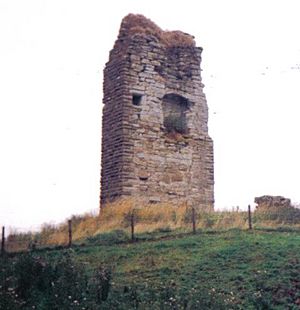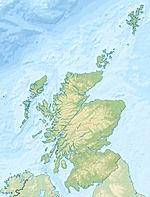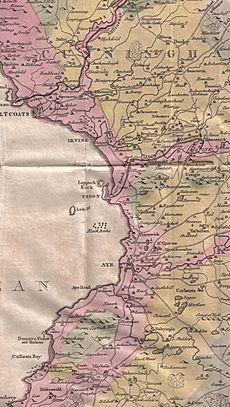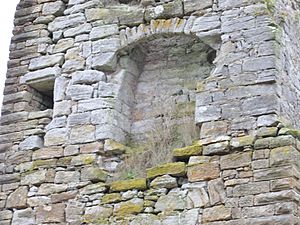Barony and Castle of Corsehill facts for kids
Quick facts for kids Corsehill Castle |
|
|---|---|
| Stewarton, East Ayrshire, Scotland GB |
|

The remains of Corsehill Castle
|
|
| Coordinates | 55°41′12″N 4°31′09″W / 55.686787°N 4.519261°W |
| Site information | |
| Owner | Private |
| Open to the public |
No |
| Condition | Ruin |
| Site history | |
| Built | 16th Century |
| Built by | Cunningham |
| Materials | Stone |
Corsehill Castle is an old ruined castle in Stewarton, East Ayrshire, Scotland. It was once part of a large area of land known as the Barony of Corsehill. The castle and its lands were important in the history of the local area.
Contents
The Story of Corsehill Castle
The first known owner of Corsehill Castle and its lands was Godfrey de Ross. His family later became known as the Earls of Glasgow.
Later, in 1532, the Cunningham family took over Corsehill. Andrew Cunningham, the second son of the 4th Earl of Glencairn, was the first Cunningham to own Corsehill. He was a strong supporter of new religious ideas at the time.
His son, Cuthbert Cunningham, inherited the lands. Over the years, many Alexanders from the Cunningham family owned Corsehill. One Alexander Cunningham became a Baronet in 1672. A Baronet is a special title, like a knight, that can be passed down through the family.
Records from 1691 show that Corsehill House had ten fireplaces, which meant it was a large and important home. Many other houses were also part of the Corsehill lands. David Cunningham was the last family member to live in Corsehill House.
The Cunningham family continued to own the lands for many generations. In 1820, the Corsehill lands included several smaller areas like Lainshaw and Chapeltoun.
A War Hero from Corsehill
One notable owner was Sir William James Montgomery Cuninghame, the ninth Baronet. He was born in 1834 and was a brave soldier. He fought in the Crimean War as a Lieutenant.
In 1854, William was part of a group that pushed back Russian soldiers from their hiding spots. Even after his commanding officer was killed, William and another soldier bravely held their ground against several attacks all night. For his courage, William was awarded the Victoria Cross, which is the highest military award for bravery in the United Kingdom.
William later became a Colonel and even served in Parliament from 1874 to 1880. His Victoria Cross medal is now kept in a museum.
Today, the Montgomery-Cuninghame Baronets of Corsehill are still the heads of the Clan Cunninghame family.
Old Corsehill Castle and Corsehill House
For a long time, people have been confused about the different old buildings in Stewarton. There were two main places called Corsehill: the very old Corsehill Castle and a later home called Corsehill House.
The name Corsehill probably comes from Cross Hill. In early Christian times, wooden crosses were often put on hills for religious gatherings.
The old Corsehill Castle is now just a single section of a tower wall. It has been repaired to keep it from falling down, which gives it a unique look. You can still see a fireplace and a small cupboard (called an aumbry) on one side. This shows that it was once a proper building.
Corsehill House was a different building, built later. An old drawing from 1789 shows Corsehill House. It was said that a much older building, the original Corsehill Castle, was nearby. Most of Corsehill House was taken down around 1800, and its stones were used to build a railway embankment.
Maps from different times show the confusion. Some maps show "Reuinskraig" (meaning "ruined rock") on one side of the Corsehill Burn, and "Corshill" on the other. It seems that "Reuinskraig" was just a description for the ruined Old Corsehill Castle.
Today, only the small part of the old tower of Corsehill Castle remains. It's a reminder of the area's long history.
The Baron-Court Book
An interesting old book called the 'Baron-Court book of the Baron-Court of Corshill' still exists. It was found in Stewarton and published in 1884. This book contains records from 1666 to 1719. It tells us about the local court and how people were punished. For example, in 1667, a man named Hew Harper was fined and put in the stocks.
King's Kitchen
There's a local story about an old cottage in Stewarton called "King's Kitchen Head." It was near Corsehill Castle. The story says that a king, while traveling to judge people, stayed at this cottage. The wife of the house begged the king to spare her husband, who was one of the people to be judged. The king let her husband go, telling him to "be a better bairn" (meaning, behave better).
Corsehill Castle and King Malcolm Canmore
A famous local legend connects Corsehill Castle to King Malcolm Canmore, who ruled Scotland from 1058 to 1093.
The story says that after Macbeth murdered King Duncan I, Duncan's son, Malcolm Canmore, tried to find safety at Corsehill Castle. Macbeth's men were close behind him. Malcolm saw a peasant named Friskin working in a field. Friskin quickly hid Malcolm, who then escaped to England.
In England, King Edward the Confessor gave Malcolm an army. Malcolm returned to Scotland, defeated Macbeth, and became King Malcolm III. To thank Friskin, the grateful king gave him the lands of Cunninghame. Friskin's family then took the name Cunningham and adopted the motto 'Over Fork Over'. This motto is said to come from their role as "Masters of the king's horses," using a play on words related to a hay fork.
While this story is very old and popular, it doesn't quite match historical records. However, it's a fun legend that shows how important Corsehill Castle was in local tales. Interestingly, there's a "MacBeth Hill" near Old Corsehill Castle in Stewarton.
More Interesting Facts
- The owners of the nearby lands of Cocklebie had the special right to hold a weekly market and four yearly fairs.
- Sir A. Cunningham of Corsehill attended the famous Eglinton Tournament in 1839, a grand medieval-style festival.
- In the early 1600s, the area around Stewarton was so busy and full of houses that people said it was more crowded than some walled cities in Europe. It was said that if a bell rang at night, 3,000 strong men, well-armed and on horseback, could gather in just a few hours.
- In 1820, only six people in Stewarton Parish were allowed to vote, as they were the main landowners, including the owner of Corsehill.
- The Draffen Stone, a large stone, was moved from a field to outside Draffen House in Stewarton. No one is sure if it was a rubbing stone for cattle or an ancient standing stone.
- The Lairds of Corsehill were in charge of the "Bonnet Court," which controlled the work of the famous Stewarton bonnet makers.
- The first "Corsehill Queen" is jokingly said to be Queen Margaret, King Malcolm III's second wife. She was made a saint, and her chapel is the oldest building at Edinburgh Castle.
Images for kids









